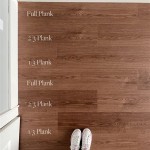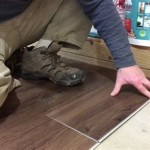How to Remove Vinyl Floor Glue From Concrete
Removing vinyl flooring glue from concrete is a common challenge faced by homeowners and contractors during renovation projects. The adhesive, designed for strong bonding, often leaves a stubborn residue that can hinder the installation of new flooring materials. Successfully removing this glue requires patience, the right tools, and an understanding of different techniques suitable for various types of adhesives and concrete surfaces.
The difficulty in removing vinyl floor glue stems from its composition. Many adhesives used for vinyl flooring are solvent-based or acrylic-based, creating a resilient bond with the porous surface of concrete. Over time, these adhesives can harden and become increasingly resistant to removal, necessitating a multi-pronged approach.
Before commencing the removal process, it is paramount to identify the type of adhesive used. While visual identification might be challenging, knowing the age of the flooring and any available documentation can provide valuable clues. Older adhesives often contain asbestos, demanding professional handling and adherence to strict safety regulations. If there is any suspicion of asbestos, testing by a certified professional is mandatory.
Safety precautions are crucial throughout the entire removal process. Wearing appropriate personal protective equipment (PPE) is mandatory. This includes safety glasses to protect the eyes from debris and chemical splashes, heavy-duty gloves to safeguard the hands from irritants and sharp objects, and a respirator to prevent inhalation of dust and fumes. Proper ventilation is also essential, especially when using chemical solvents. Opening windows and using fans to circulate air can mitigate the risk of respiratory irritation.
Preparing the Area for Glue Removal
Proper preparation is a critical first step that significantly impacts the efficiency and effectiveness of the glue removal process. This involves clearing the area of any furniture, debris, or loose materials. Sweep or vacuum the concrete surface thoroughly to remove dirt, dust, and any remaining pieces of vinyl flooring. This cleanliness ensures that the removal methods target the glue directly and prevents interference from other substances.
Protecting surrounding areas is also essential to prevent damage from chemicals or mechanical tools. Using drop cloths or plastic sheeting to cover nearby walls, baseboards, and other surfaces will safeguard them from accidental spills, scratches, or dust. Taping the edges of the protected areas ensures a secure barrier.
If the concrete surface has any cracks or imperfections, addressing them before glue removal can be beneficial. Filling these cracks with concrete patching compound prevents the glue removal process from further exacerbating the damage. Allow the patching compound to fully cure according to the manufacturer's instructions before proceeding.
Methods for Removing Vinyl Floor Glue
Several methods can be employed to remove vinyl floor glue from concrete, each with its own advantages and disadvantages. The choice of method depends on the type of adhesive, the extent of the glue residue, and the condition of the concrete. Often, a combination of methods proves most effective.
Scraping: Scraping is a fundamental method that involves using a handheld scraper or a floor scraper tool to manually remove the glue. This method is most effective for removing thick layers of glue or loose adhesive residue. A floor scraper, which has a long handle, allows for standing operation, reducing strain on the back. Use a sharp, sturdy scraper blade to avoid bending or breaking. Apply firm, even pressure while scraping to lift the glue from the concrete. Be cautious not to gouge or damage the concrete surface during the scraping process. Multiple passes may be required to remove stubborn areas.
Heat Gun: Applying heat can soften the adhesive, making it easier to scrape away. A heat gun, when used carefully, can be a valuable tool for this purpose. Hold the heat gun a few inches above the glue, moving it slowly and evenly to avoid overheating or scorching the concrete. The goal is to soften the glue, not to burn it. Once the glue is pliable, use a scraper to remove it. Work in small sections to maintain the glue's softened state. Exercise caution when using a heat gun, as it can cause burns. Wear heat-resistant gloves and avoid prolonged exposure to the heat.
Chemical Solvents: Chemical solvents can dissolve or soften the adhesive, facilitating its removal. Several types of solvents are available, including those specifically designed for adhesive removal. Before using any solvent, carefully read and follow the manufacturer's instructions and safety precautions. Test the solvent in an inconspicuous area of the concrete to ensure it does not damage or discolor the surface. Apply the solvent liberally to the glue residue and allow it to dwell for the recommended time, typically 15-30 minutes. This dwell time allows the solvent to penetrate and soften the adhesive. After the dwell time, use a scraper to remove the softened glue. Repeat the process if necessary. Ensure adequate ventilation when using chemical solvents, as they can emit fumes. Some common solvents include mineral spirits, adhesive removers, and citrus-based cleaners. Always dispose of used solvents according to local regulations.
Grinding: For large areas with stubborn glue residue, a concrete grinder can be an efficient solution. Concrete grinders use abrasive pads or diamond grinding wheels to remove the glue mechanically. This method is particularly effective for removing thin layers of adhesive or smoothing out uneven surfaces. Use a grinder with a dust collection system to minimize airborne particles. Wear a respirator to protect against dust inhalation. Start with a coarse grinding pad and gradually move to finer pads to achieve a smooth, even surface. Be careful not to grind too aggressively, as this can damage the concrete. Overlapping passes are crucial to ensure uniform removal. Regularly inspect the grinding pads for wear and replace them as needed.
Steam Removal: Steam can be used to loosen up certain types of vinyl floor glue, especially those that are water-based. The moist heat penetrates the adhesive, weakening its bond with the concrete. A steam cleaner or steamer can be used to apply steam to the glued surface. Hold the steam nozzle close to the glue and move it slowly over the area. Allow the steam to dwell for a few seconds to saturate the adhesive. Use a scraper to remove the softened glue. This method is often less aggressive than chemical solvents or grinding, making it a suitable option for delicate concrete surfaces. It may require more time and effort compared to other methods, especially for thicker layers of glue.
Neutralizing and Cleaning the Concrete
After removing the bulk of the glue residue, it is essential to neutralize and clean the concrete surface. This step removes any remaining adhesive residue and prepares the surface for the installation of new flooring materials. The specific cleaning process depends on the methods and materials used during glue removal.
If chemical solvents were used, thoroughly rinse the concrete surface with clean water to remove any lingering solvent residue. For areas treated with heat or steam, wipe down the surface with a damp cloth to remove any loosened debris. Consider using a neutral pH cleaner to ensure all traces of the removal agents are eliminated. Allow the concrete to dry completely before proceeding.
Inspect the concrete surface for any remaining glue residue. If necessary, repeat the removal process on any stubborn areas. A final scrubbing with a stiff-bristled brush and a mild detergent can help remove any remaining traces of adhesive. Rinse the surface thoroughly and allow it to dry completely.
Once the concrete is clean and dry, consider applying a concrete primer or sealer. This can help create a uniform surface for the new flooring material, improving adhesion and preventing future issues. Choose a primer or sealer that is compatible with both the concrete and the new flooring.
Key Considerations for Specific Adhesive Types
The effectiveness of different removal methods can vary depending on the type of vinyl floor adhesive used. Understanding the characteristics of common adhesive types can guide the selection of the most appropriate removal techniques.
Water-Based Adhesives: These adhesives are generally easier to remove compared to solvent-based adhesives. Steam, hot water, and certain enzymatic cleaners can be effective in softening and dissolving water-based adhesives. Scraping is often sufficient for removing the softened residue. Avoid using harsh solvents that could damage the concrete.
Solvent-Based Adhesives: Solvent-based adhesives are more resistant to removal and often require the use of chemical solvents. Choose a solvent specifically designed for adhesive removal, and follow the manufacturer's instructions carefully. Ensure adequate ventilation when using solvents. Multiple applications may be necessary to fully dissolve the adhesive.
Epoxy Adhesives: Epoxy adhesives are extremely strong and durable, making them the most challenging type to remove. Grinding is often the most effective method for removing epoxy adhesives. Chemical solvents that are specifically formulated for epoxy removal can also be used, but they may require extended dwell times and multiple applications. Heat can sometimes soften epoxy, but care must be taken to avoid damaging the concrete.

The Fastest Way To Remove Bonded Vinyl Flooring From Concrete

How To Remove Carpet Glue From Concrete 4 Proven Ways Network

Removing Linoleum Flooring Glue From Concrete Floor

How To Remove Carpet Glue From Concrete 4 Proven Ways Network

How To Remove Carpet Glue From Concrete Floor Step By Guide

How To Remove Adhesive From Concrete Floors 5 Diy Ways Get Glue Off

How To Remove Vinyl Flooring The Home

How To Remove Old Floor Tile Adhesive All Stripped

How To Remove Adhesive From Concrete Floors 5 Diy Ways Get Glue Off

Thinset Mastic And Glue Removal Craftsman Concrete Floors
See Also







